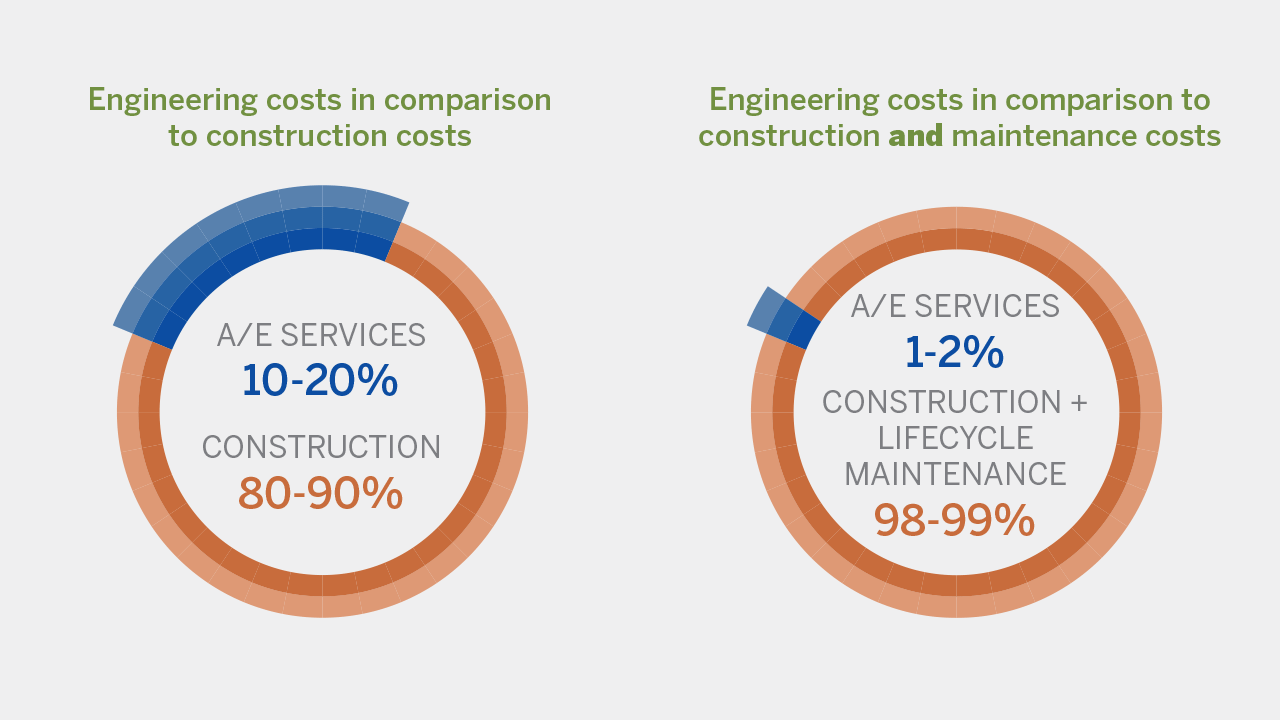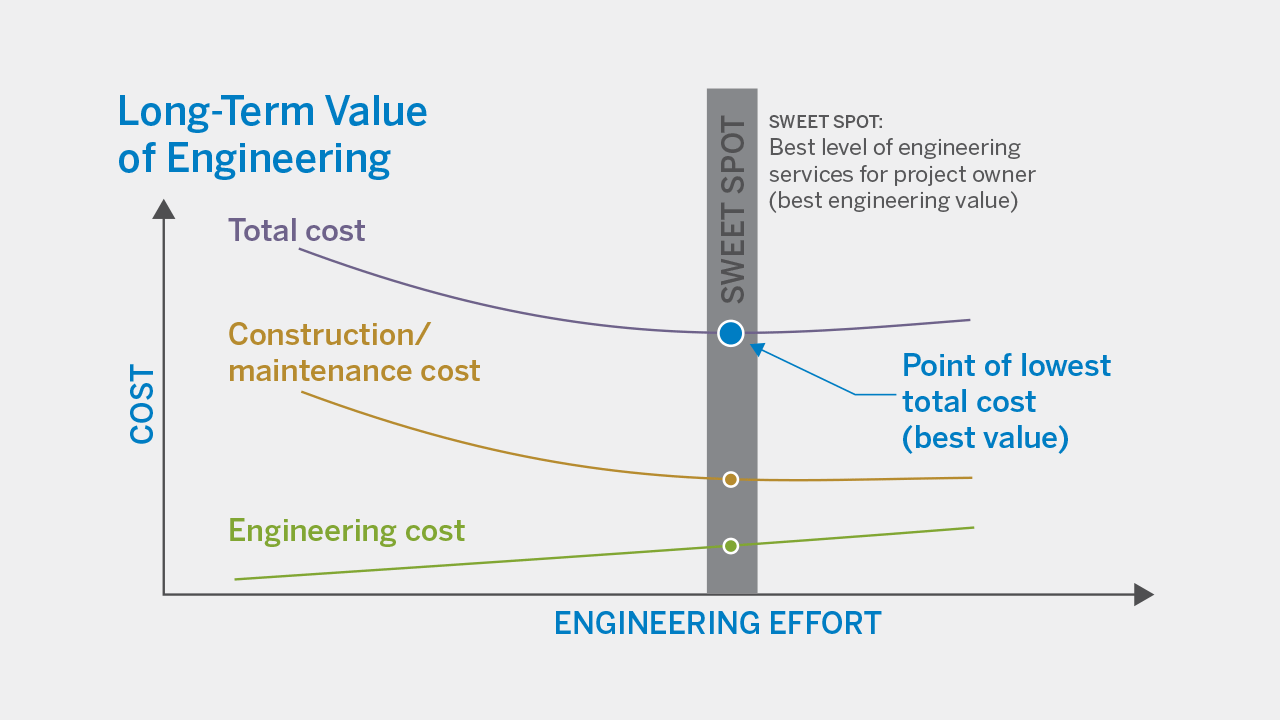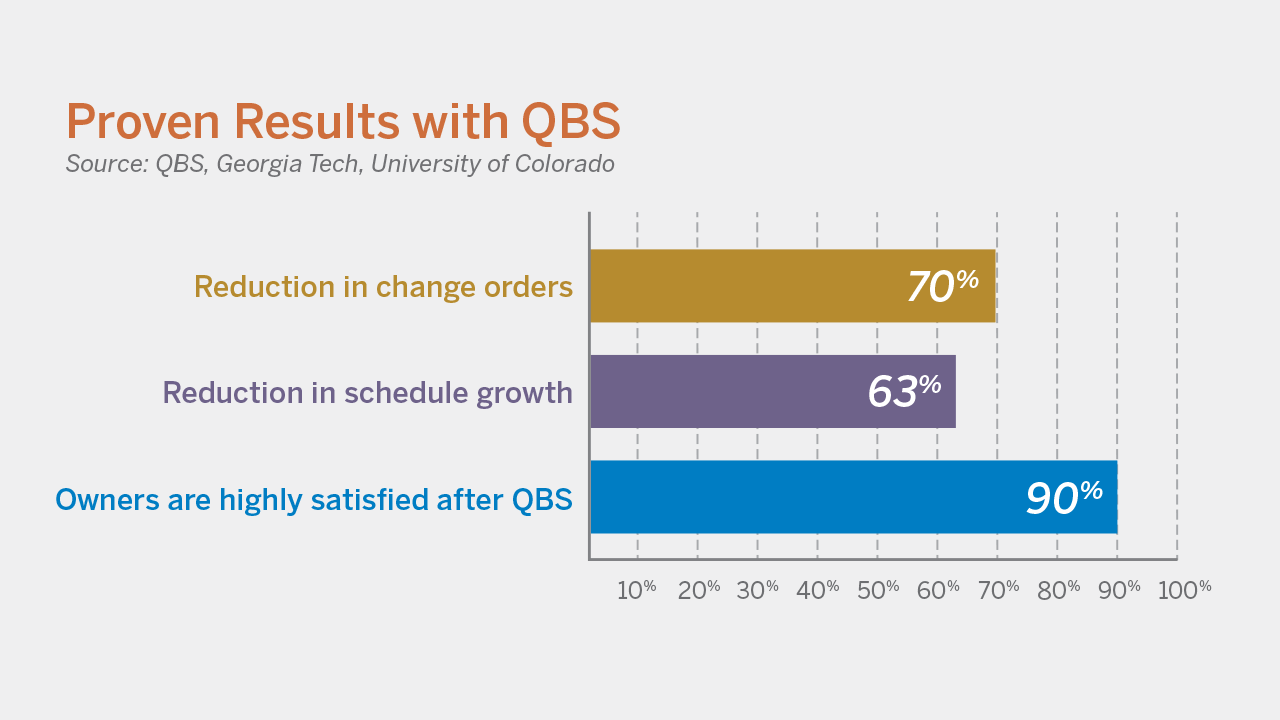Cost efficiency is critical, but prioritizing engineering cost alone when making major project decisions can increase your expenses and limit the value you receive.
How the engineering sweet spot lowers total cost, improves quality
If you spend too much on engineering, there is a point of diminishing returns, and your total project cost may end up higher than necessary. Conversely, rushed or lack of strategic engineering can lead to poorly planned and inadequately designed projects – leading to more change orders, inaccurate construction contractor bids, and higher construction and maintenance costs.
Digging deeper, though this percentage varies depending on a number of factors, the cost of engineering for a typical project is often just 10-20 percent of your total project costs when factoring in both engineering and construction. When you add lifecycle maintenance to the equation, the cost of engineering services for a typical project is even less at 1-2 percent of total project costs.

Despite the low cost impact, the strategic impact of engineering is far-reaching because it influences nearly every aspect of your projects:
- Budget
- Schedule
- Site selection
- Permitting
- Design alternatives
- Aesthetics
- Operating costs
- Maintenance needs and costs
- Community outreach
- Stakeholder buy-in
While engineering represents a fraction of total project costs, investing the right amount in this phase can result in long-term savings and greater return. Finding the engineering sweet spot can lower your construction and maintenance costs, lower total cost, and provide you with the best possible value for your dollars.
With every project there is a direct relationship between total cost, construction and maintenance costs, and engineering costs. As shown in the illustration below, they shift together depending on your investment. Not enough engineering can dramatically increase the lifecycle costs of your project; too much can also increase costs. Strategically balancing engineering, construction, and maintenance costs collectively ensures your total project cost lands in the sweet spot – the greatest value.

How quality-based selection helps uncover the cost vs. quality sweet spot
Cost is often the first thing project owners look at when soliciting proposals for engineering services and making project hiring decisions. It’s understandable why this is so; return on investment, financial viability, and the economic health of your community are top priorities.
However, solely focusing on cost can inadvertently lead to diminished value in several ways:
- Higher operations and maintenance costs (therefore higher total project costs)
- Rushed, sub-par or too much infrastructure
- A consultant partner who cares only about the project at hand rather than your long-term goals
To counter this, many project owners prefer quality-based selection (QBS) as their preferred process. QBS helps uncover the engineering cost sweet spot by emphasizing the consultants' competency, qualifications, and experience, rather than price factors. Price negotiations come into practice only after completing the QBS process, ensuring that the chosen consultants are best suited to deliver both quality and value for the project.
I can attest that choosing based on quality doesn't necessarily mean higher costs. On the contrary, it ensures impartiality, promotes healthy competition, and eliminates the risk of unrealistic, undercutting bids.
-Stacy Crakes, SEH Professional Engineer
3 proven benefits of quality-based selection
1) QBS protects your budget
A well-designed project and qualified team will keep things on schedule and budget. This also ensures fewer change orders during design and construction and reduces maintenance. In fact, research by the University of Colorado and Georgia Tech found that QBS lowers construction costs and makes it more likely for schedules to be met.
2) QBS creates fully defined, aligned project scopes
QBS gives you the ability to fully craft and define your project scope during the selection process or in partnership with the selected engineering consultant. This process creates an aligned, cost-efficient partnership from day one which limits change orders, ensures quality infrastructure and activates accountability.
3) QBS supports public health and safety
Engineers design our highways and bridges, our water treatment systems, and the public service and safety buildings that serve our communities, to name just a few – meaning design services directly impact the health and safety of the public. QBS ensures these systems are delivered at the highest possible quality.
Brief overview: the quality-based selection process
Project owner announces the need for engineering services and invites interested firms to submit qualifications (e.g., team, experience, and expertise). The proposed project budget or capital improvement plan budget is often shared with competing firms.
Shortlist of 2-3 firms is developed. Interviews are often conducted to discuss each firm’s qualifications, philosophies, experience, and overall approach to the project.
Project owner ranks each engineering consultant based on quality. The top-ranked firm is invited to negotiate a formal agreement – including a discussion of the owner’s concepts and goals, alternatives, specific scope of work, and compensation. Here, the owner has the opportunity to carefully evaluate cost proposal.
Project owner is free to terminate negotiations if they’re unsatisfied with the approach or price. If unsatisfied, the owner can elect to move on to the next most qualified engineering consultant.
Take action: use quality-based selection to develop a trusted “pool”
Many municipalities and private project owners use QBS to develop a trusted, qualified pool of engineering consultants to hire and return to for future projects. With this pool, project owners are confident in the quality they’ll receive; they can freely assign projects based on specialty and know with certainty they’re receiving value for their dollars. Fee negotiations take place, but the process is seamless, given the trusted relationships in place.
For example, City X has bridge renovation, water tower inspection, and fire station re-design projects on the horizon. The City can select the best-suited firm from their pool for each project; procuring the consultant with more water engineering experience to undertake the tower inspection while assigning the fire station design to a dedicated architecture team with relevant experience.
The City can skip the time-consuming, expensive effort of developing and releasing a full request for proposal – along with evaluation, vetting, interviews, and selection – because they have done the work to create a group to choose from confidently. Once the City selects its team, they can collaborate to determine the precise scope of work. Above all, the City knows it’s paying for and receiving the best value before signing any contracts.
QBS establishes the groundwork for enhanced quality and reduced expenses, while alleviating concerns about encountering undervalued or unattainable proposals. When presented with a diverse pool of A/E consultants, each with their unique expertise, the returns increase exponentially.
- Jeremiah Wendt, SEH Professional Engineer
5 FAQs surrounding quality-based selection
1. Why shouldn’t we bid engineering services similar to construction contracts?
Consultants take a project owner’s idea and create its definition. This demands high quality to ensure it’s done right, or all other phases can fall apart. Construction contractors then take this “definition” and build it. As a result, bidding and selecting a construction contractor differs greatly from selecting an engineering consultant for design. With a precise set of plans and specifications from the consultant, you can confidently award construction contracts to the lowest (most responsible) bidder because all major aspects of the project have been developed – including the type and amount of materials needed.
2. Why isn’t price a factor in the QBS process?
Cost discussions cannot be meaningful until the project owner and consultant understand in detail what services and solutions are needed. By focusing first on qualifications, project owners are certain the selected consultant has the technical capabilities, experience, and judgment to turn their vision into reality. Trust is also established, leading to fair cost negotiations and the best possible value.
3. Does QBS promise fewer project challenges?
Studies by the American Council of Engineering Companies (ACEC) have shown that projects completed using QBS have shorter schedules and fewer change orders. Fewer change orders keep your budget a priority and ensure the lowest cost. QBS followed by cost negotiations creates a transparent relationship between you and the consultant from day one.
4. Does QBS increase total project costs?
Negotiated design fees are usually 1-2 percent of a project’s total lifecycle costs. Yet, the time spent uncovering the best solution for your project has a dramatic impact on long-term operations and maintenance. QBS places you and the selected consultant on the same page regarding budget, schedule, and goals. You then have full power to negotiate a contract you’re confident in. This limits your costs and lays the groundwork for higher ROI throughout the life of your project.
5. How can we know for certain we’re getting a fair price?
You need to have detailed discussions around your project scope and expectations. This will enable the selected engineering consultant to develop the most accurate professional services budget. From here, you can compare the consultant’s proposed budget to budgets from successful past projects to ensure you’re getting the fairest price. Once trust is established with your consultant, or the well of consultants you rely on, cost remains a priority but never at the expense of quality.
This and more can be found in our latest eBook, How Much Should You Pay for Engineering Services? In this eBook, I and others with consultant and client experience share tips to help you answer this ever-pressing question. We also share cost proposal warning signs, how to ensure promises of value-added services are delivered, and the key factors in cost increases and uncertainties.
About the Experts

Jeremiah Wendt, PE*, is a senior engineer and project manager with 20 years of public and private sector experience in design, project management, and people management. His public sector experience includes oversight of transportation, recreation, and utility infrastructure facilities. His consulting experience primarily focuses on planning, design, construction, and funding of wastewater conveyance and treatment facilities.
*Registered Professional Engineer in IN, NE, SD, WI, VA

Stacy Crakes, PE*, is a business development manager with 20+ years of public and private sector experience in engineering, project management, and leading economic development efforts, including department budgeting and finance, planning, and program development. She has managed grant programs for feasibility and land use studies as well as developed and managed efforts on numerous wind energy, aviation, traffic, and railroad projects.
*Registered Professional Engineer in MN

.png?width=113&name=SEH_Logo_RGB%20(1).png)
